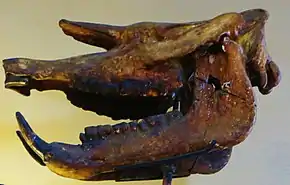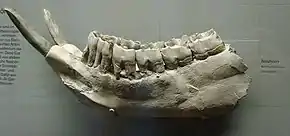Aceratheriinae
Les Aceratheriinae (parfois Aceratherinae) forment une sous-famille éteinte de rhinocéros ayant vécu en Asie, Afrique, Europe et Amérique du Nord durant un long intervalle de temps de l'Oligocène jusqu'au Pliocène voire jusqu'au Pléistocène moyen, c'est-à-dire il y a environ entre 33,9 et 0,3 Ma (millions d'années)[1].
Aceratheriinae

Aceratherium incisivum au Muséum national d'histoire naturelle à Paris.
Taxonomie

près de Madrid.

du genre Aceratherium par Heinrich Harder en 1920.

au Musée national d'histoire naturelle de Stuttgart.
La sous-famille des Aceratheriinae a été érigée par le paléontologue belge Louis Dollo en 1885. Elle a été rattachée aux Rhinocerotida par Codrea (1992), et aux Rhinocerotidae par Prothero (1998), Antoine et al. (2000), Kaya et Heissig (2001), Sach et Heizmann (2001) et Deng (2005)[2],[3],[4].
Liste des genres
- † Aceratherium
- † Acerorhinus
- † Alicornops
- † Aphelops
- † Aprotodon
- † Brachydiceratherium
- † Brachypodella
- † Brachypotherium
- † Chilotherium
- † Diaceratherium
- † Dromoceratherium
- † Floridaceras
- † Galushaceras
- † Hoploaceratherium
- † Mesaceratherium
- † Peraceras
- † Persiatherium
- † Plesiaceratherium
- † Proaceratherium
- † Prosantorhinus
- † Shansirhinus
- † Subchilotherium
- † Teleoceras
Références
- (en) PaleoBiology Database: Aceratheriinae, basic info
- (en) V. Codrea. 1992. New mammal remains from the Sarmatian deposits an Minisu de Sus (Taut, Arad County). Studia Universitatis Babes-Bolyai, Geologica 2:35-41
- (en) D. R. Prothero. 1998. Rhinocerotidae. in C. M. Janis, K. M. Scott, and L. L. Jacobs (eds.), Evolution of Tertiary mammals of North America 595-605
- (fr) P.-O. Antoine, C. Bulot, and L. Ginsburg. 2000. Une faune rare de rhinocérotidés (Mammalia, Perissodactyla) dans le Miocène inférieur de Pellecahus (Gers, France). Géobios 33(2):249-255
Références taxinomiques
(en) Référence Paleobiology Database : Aceratheriinae Dollo, 1885
Annexes
Articles connexes
- Portail des mammifères
- Portail de la paléontologie
- Portail du Cénozoïque
Cet article est issu de Wikipedia. Le texte est sous licence Creative Commons - Attribution - Partage dans les Mêmes. Des conditions supplémentaires peuvent s'appliquer aux fichiers multimédias.